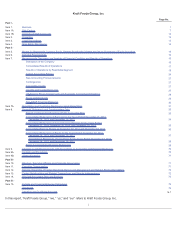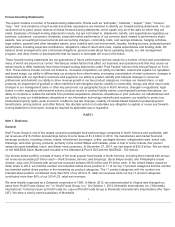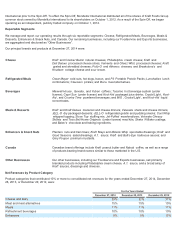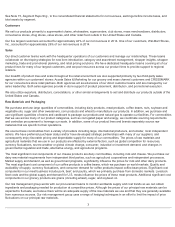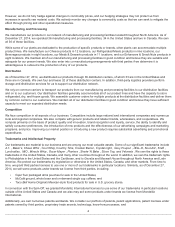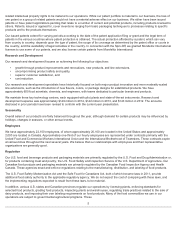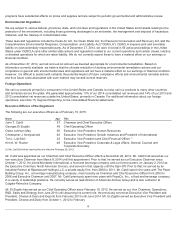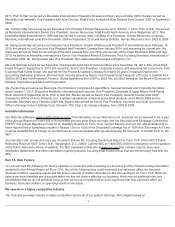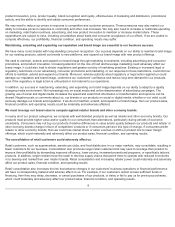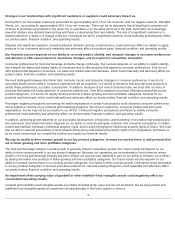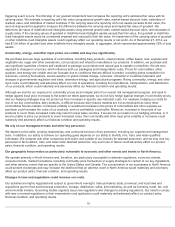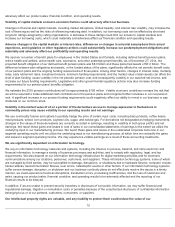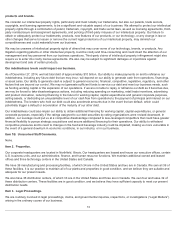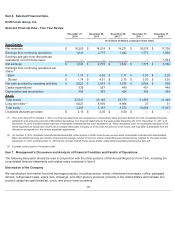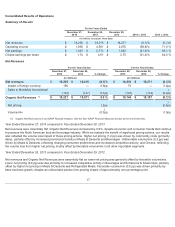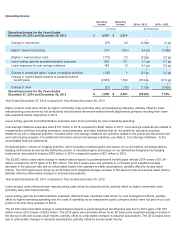Kraft 2014 Annual Report Download - page 12
Download and view the complete annual report
Please find page 12 of the 2014 Kraft annual report below. You can navigate through the pages in the report by either clicking on the pages listed below, or by using the keyword search tool below to find specific information within the annual report.
product innovation, price, product quality, brand recognition and loyalty, effectiveness of marketing and distribution, promotional
activity, and the ability to identify and satisfy consumer preferences.
We may need to reduce our prices in response to competitive and customer pressures. These pressures may also restrict our
ability to increase prices in response to commodity and other cost increases. We may also need to increase or reallocate spending
on marketing, retail trade incentives, advertising, and new product innovation to maintain or increase market share. These
expenditures are subject to risks, including uncertainties about trade and consumer acceptance of our efforts. If we are unable to
compete effectively, our profitability, financial condition, and operating results may suffer.
Maintaining, extending and expanding our reputation and brand image are essential to our business success.
We have many iconic brands with long-standing consumer recognition. Our success depends on our ability to maintain brand image
for our existing products, extend our brands to new platforms, and expand our brand image with new product offerings.
We seek to maintain, extend, and expand our brand image through marketing investments, including advertising and consumer
promotions, and product innovation. Increasing attention on the role of food and beverage marketing could adversely affect our
brand image. It could also lead to stricter regulations and greater scrutiny of marketing practices. Existing or increased legal or
regulatory restrictions on our advertising, consumer promotions and marketing, or our response to those restrictions, could limit our
efforts to maintain, extend and expand our brands. Moreover, adverse publicity about regulatory or legal action against us could
damage our reputation and brand image, undermine our customers’ confidence and reduce long-term demand for our products,
even if the regulatory or legal action is unfounded or not material to our operations.
In addition, our success in maintaining, extending, and expanding our brand image depends on our ability to adapt to a rapidly
changing media environment. We increasingly rely on social media and online dissemination of advertising campaigns. The
growing use of social and digital media increases the speed and extent that information or misinformation and opinions can be
shared. Negative posts or comments about us, our brands or our products on social or digital media, whether or not valid, could
seriously damage our brands and reputation. If we do not maintain, extend, and expand our brand image, then our product sales,
financial condition and operating results could be materially and adversely affected.
We must leverage our brand value to compete against retailer brands and other economy brands.
In nearly all of our product categories, we compete with well-branded products as well as retailer and other economy brands. Our
products must provide higher value and/or quality to our consumers than alternatives, particularly during periods of economic
uncertainty. Consumers may not buy our products if relative differences in value and/or quality between our products and retailer or
other economy brands change in favor of competitors’ products or if consumers perceive this type of change. If consumers prefer
retailer or other economy brands, then we could lose market share or sales volumes or shift our product mix to lower margin
offerings, which could materially and adversely affect our product sales, financial condition, and operating results.
The consolidation of retail customers could adversely affect us.
Retail customers, such as supermarkets, warehouse clubs, and food distributors in our major markets, may consolidate, resulting in
fewer customers for our business. Consolidation also produces larger retail customers that may seek to leverage their position to
improve their profitability by demanding improved efficiency, lower pricing, increased promotional programs, or specifically tailored
products. In addition, larger retailers have the scale to develop supply chains that permit them to operate with reduced inventories
or to develop and market their own retailer brands. Retail consolidation and increasing retailer power could materially and adversely
affect our product sales, financial condition, and operating results.
Retail consolidation also increases the risk that adverse changes in our customers’ business operations or financial performance
will have a corresponding material and adverse effect on us. For example, if our customers cannot access sufficient funds or
financing, then they may delay, decrease, or cancel purchases of our products, or delay or fail to pay us for previous purchases,
which could materially and adversely affect our product sales, financial condition, and operating results.
8



